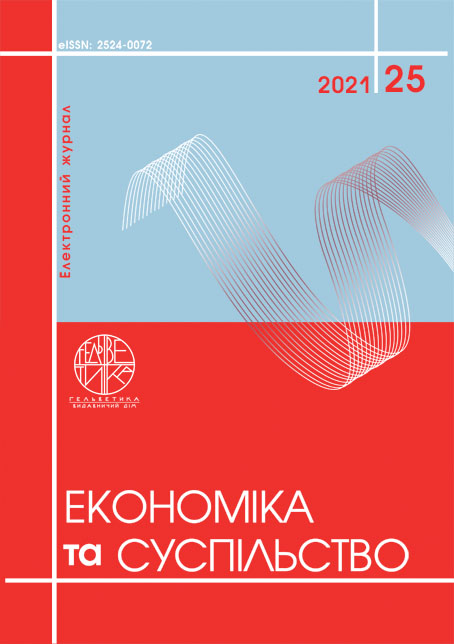CURRENT PRACTICE OF ASSESSING THE ECONOMIC SUSTAINABILITY OF THE ENTERPRISE: ADVANTAGES AND DISADVANTAGES
Abstract
The article analyzes the existing methods of assessing the economic stability of the enterprise. The methodical tools and procedures for assessing the economic stability of the enterprise have researched and substantiated, with the definition of advantages and disadvantages. The grouping of methods for assessing economic stability, which allowed to form certain conclusions about the characteristics of the existing tools, the content of criteria, the need for some systematization and acceptability. It is established that with the help of integrated assessment of economic stability it is possible to estimate not only its general level on the basis of use of the developed scale, but also to carry out an estimation of separate structural elements of stability of the enterprise. This technique has characterized by the use of existing methods of evaluating a certain set of indicators, there is a supplement and increase the possibilities of traditional analysis, as well as a comparison of the obtained indicators with different standards, standards, criteria. The obtained calculated results of integrated evaluation has been used in the process of evaluating the effectiveness of management decisions, their justification for further implementation at the required hierarchical levels of management. The obtained conclusions regarding the forms and content of indicators for assessing the economic stability of the enterprise allow us to state that in modern practice there is no single generally accepted method of assessment. Almost every researcher, whose research interests are to study methods of assessing economic stability, recommends the use of their own version of the formalization of the indicator, providing in justifying its content and possibilities of application in practice of certain arguments. The above considerations necessitate the development of a theoretical and methodological approach to assessing the economic stability of the enterprise (for example, telecommunications enterprises) in conditions of uncertainty based on comprehensive coverage of all major aspects of functioning in the modern market space.
References
Брагінець А.М. Економічна стійкість підприємств в сучасних умовах господарювання. Науковий вісник Луганського національного аграрного університету. 2009. № 5. С. 49–57.
Ульянченко О.В. Формування та використання ресурсного потенціалу в аграрній сфері: монографія. Харків : ХНАУ, 2006. 357 с.
Тридід О.М. Комплексна оцінка конкурентного статусу підприємства. Економіка розвитку. 2002. № 2. С. 75–76.
Тинякова В.И. Математические методы обработки информации. Воронеж : Изд-во ВГУ, 2006. 68 с.
Семененко І.М. Економічна стійкість підприємства: сутність і поняття Вісник Східноукр. нац. ун-ту імені Володимира Даля. 2010. Вип. 2 (144). С. 78–82.
Должанський І.З., Загорна Т.О. Конкурентоспроможність підприємства: Навчальний посібник. Київ : Центр навчальної літератури, 2006. 384 с.
Афоничкин А.И., Журова Л.И. Модель оценки экономической устойчивости предприятий. Фундаментальные исследования. 2015. № 10 (Ч. 1). С. 131–136.
Ревенко Д.С., Дыба В.А. Интегральные модели экономической устойчивости предприятия и инструментальные средства ее визуализации. Вестник Восточноевропейского университета экономики и менеджмента. 2014. № 1 (16). С. 148–159.
Новоселецький О.М. Моделювання стійкості функціонування підприємства з урахуванням ризику : автореф. дис... канд. екон. наук. Держ. вищ. навч. закл. «Київ. нац. екон. ун-т ім. В. Гетьмана». Київ, 2008. 18 с.
Brahinets A.M. (2009) Ekonomichna stiikist pidpryiemstv v suchasnykh umovakh hospodariuvannia [Economic stability of enterprises in modern economic conditions]. Naukovyi visnyk Luhanskoho natsionalnoho ahrarnoho universytetu, no 5, pp. 49–57.
Ulianchenko O.V. (2006) Formuvannia ta vykorystannia resursnoho potentsialu v ahrarnii sferi [Formation and use of resource potential in the agricultural sector]. Monohrafiya [a monograph]. Kharkiv: KhNAU, 357 p. (in Ukrainian)
Trydid O.M. (2002) Kompleksna otsinka konkurentnoho statusu pidpryiemstva [Comprehensive assessment of the competitive status of the enterprise]. Ekonomika rozvytku, no 2, pp. 75–76.
Tyniakova V.I. (2006) Matematicheskie metody obrabotki informacii [Mathematical methods of information processing]. Voronezh: VGU, 68 p. (in Russian)
Semenenko I.M. (2010) Ekonomichna stiikist pidpryiemstva: sutnist i poniattia [Economic stability of the enterprise: essence and concept]. Visnyk Skhidnoukr. nats. un-tu imeni Volodymyra Dalia, no 2(144), pp. 78–82.
Dolzhanskyi I.Z., Zahorna T.O. (2006) Konkurentospromozhnist pidpryiemstva [Competitiveness of the enterprise]. Navchalnyi posibnyk [textbook]. Kyiv: Center for Educational Literature, 384 p. (in Ukrainian)
Afonichkin A.I., Zhurova L.I. (2015) Model' ocenki ekonomicheskoj ustojchivosti predpriyatij [Model for assessing the economic sustainability of enterprises]. Fundamental'nye issledovaniya, no 10 (P.1). pp. 131–136.
Revenko D.S., Dyba V.A. (2014) Integral'nye modeli ekonomicheskoj ustojchivosti predpriyatiya i instrumental'nye sredstva ee vizualizacii [Integral models of economic sustainability of an enterprise and tools for its visualization]. Vestnik Vostochnoevropejskogo universiteta ekonomiki i menedzhmenta, no 1(16), pp. 148–159.
Novoseletskyi O.M. (2008) Modeliuvannia stiikosti funktsionuvannia pidpryiemstva z urakhuvanniam ryzyku [Modeling the sustainability of the enterprise taking into account the risk]. Avtoreferat dysertatsii [a dissertation abstract]. Kyiv: KNEU, 18 p. (in Ukrainian)


